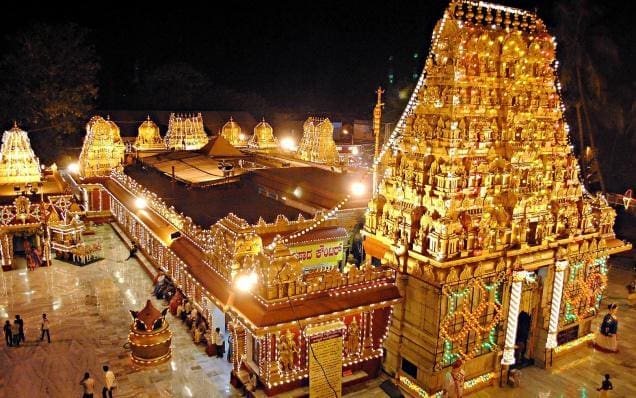
Location
Kudroli Gokarnatheshwara Temple at Mangalore is the only temple in Karnataka set up by Shree Narayana Guru, the great philosopher, saint and social reformer from Kerala. Shree Narayana Guru had visited Mangalore in 1912 and expressed his wish that the Billavas should build a temple for themselves.

Legend
H Koragapapa, who had invited the great social reformer, took the initiative and responsibility of building this temple which now stands out among the various temples of Dakshina Kannada for its sheer grandeur. The land on which the temple is built was earlier used by Tipu Sultan to graze his war horses. Hence the name Kudrevali, which over the years came to be known as Kudroli.
When Shree Narayana Guru first visited the place the land was unused and untamed. Amidst the ruins of the old temples of Dhoomavathi and Gautam there stood a lone Tulsi plant which the Guru chose as a suitable sight for the temple to be built. With his blessings the Shiva Linga was established in 1912. To the left of the Linga the idol of Annapoorneshwari was placed, to its left the Bhiarva idol, behind which the idol of Ganesh was placed. Shree Narayana Guru guided and provided various facilities to carry out daily pujas in the temple. It is said that Koragappa, who took up responsibility of building the temples, was cured of all his ailments.
The renovation committee set up to work on beautification of the temple was under Soma Sunder, son of Sri Koragappa, who had built the original temple. The renovation work transformed the temple to its present grandeur and put it on the tourist map of Mangalore.
The renovation of the temple was estimated at around Rs 1 crore. A marble statue of Shree Narayan Guru stands out as one enters the temple. His devotees presented the temple with a crown studded with precious gems. The temple was inaugurated by the late Prime Minister Rajiv Gandhi.
The Kudrole temple speaks volumes for the vibrancy of the Billava community. Billavas, meaning bow man or hunter, are the largest community in the district of Dakshina Kannada. Their chief occupation being distillation, the Billavas today have expanded their horizons into other areas of businesses and have made a significant contribution towards the prosperity of the district.
Baidya and Poojary are the surnames employed by the Billavas. The surname Poojary is most befitting to this community, because the entire bhuta (devil) worship appears to be dependent on them. In any celebration of the bhuta (or daiva), the presence of a Billava is essential. He plays the role of patri (one who gets possessed by the bhuta, along with the devil dancer). It may even be said that a good part of the practice of devil worship may be traced to this community. It was the two Billavas, Koti Baidya and Chennaya Baidya who, after their heroic end, were deified and these have been enshrined throughout Tulu country in the sthanas known as Baidarkala Garadi (shrine where Baidyas are worshipped). The story of these heroes may be taken to roughly five hundred years back, when reference to Ballalas were made in the Addana.

Be the first to comment